Modern farmhouse exteriors continue to captivate homeowners seeking the perfect blend of rustic charm and contemporary sophistication. This architectural style embraces the simplicity of traditional American farmhouses while incorporating sleek, modern elements that appeal to today's aesthetic preferences. From classic white board and batten siding with black accents to bold dark exteriors with natural stone details, modern farmhouse designs offer endless possibilities for creating stunning curb appeal. The style emphasizes clean lines, mixed materials, and functional outdoor living spaces that seamlessly connect indoor comfort with outdoor beauty.

1. Classic White Board and Batten with Black Metal Roof
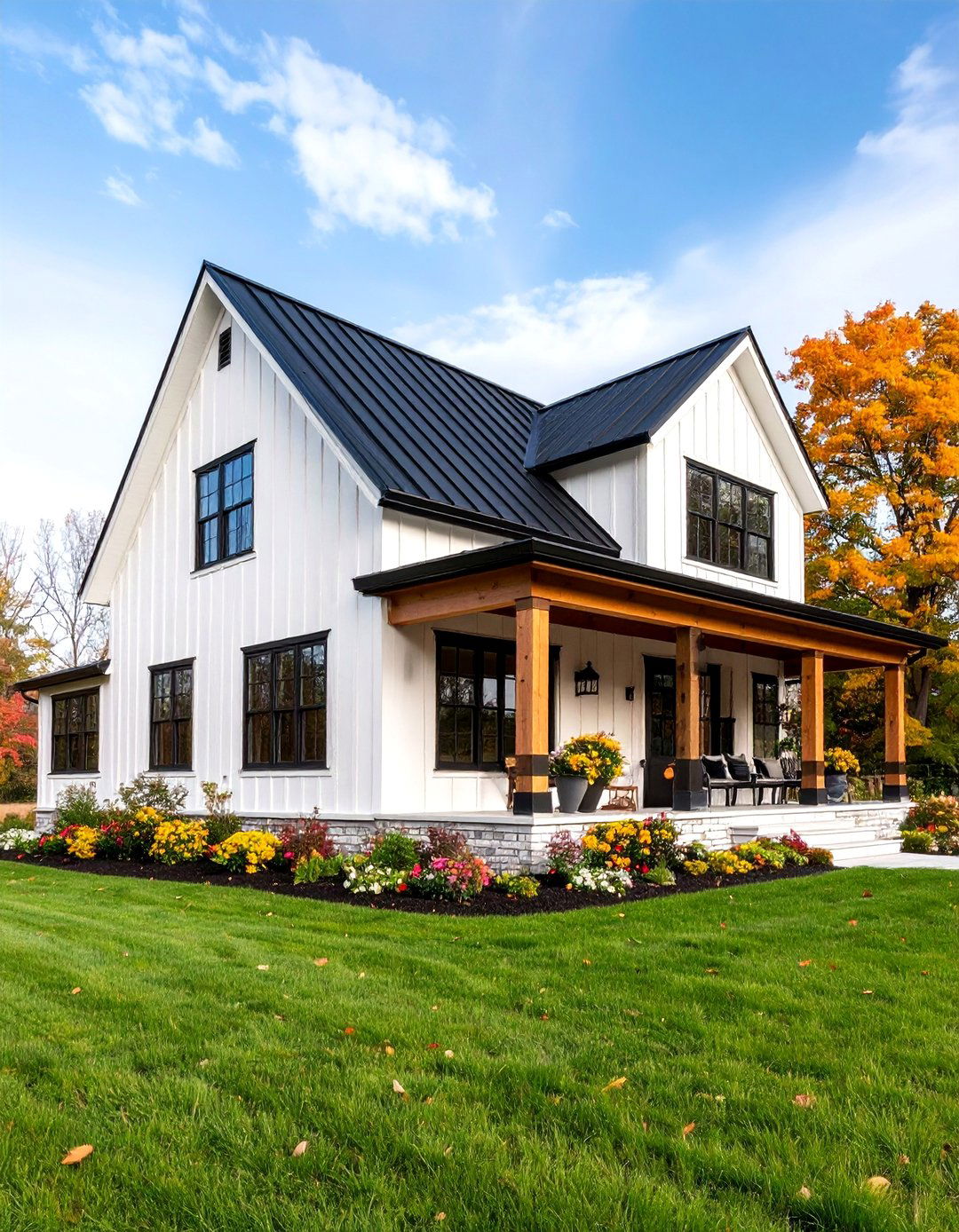
The timeless white board and batten exterior remains the cornerstone of modern farmhouse design. This vertical siding creates clean, crisp lines that emphasize height while maintaining the rustic agricultural aesthetic. Paired with a sleek black standing seam metal roof, the contrast delivers striking visual impact. Black window frames and trim provide additional definition, while white painted brick foundations anchor the design. The monochromatic palette allows architectural details to shine, from exposed wooden beams to decorative shutters. This combination works exceptionally well in various climates and provides excellent durability through James Hardie fiber cement siding options that resist fading and weather damage.
2. Modern Farmhouse with Natural Stone Accents
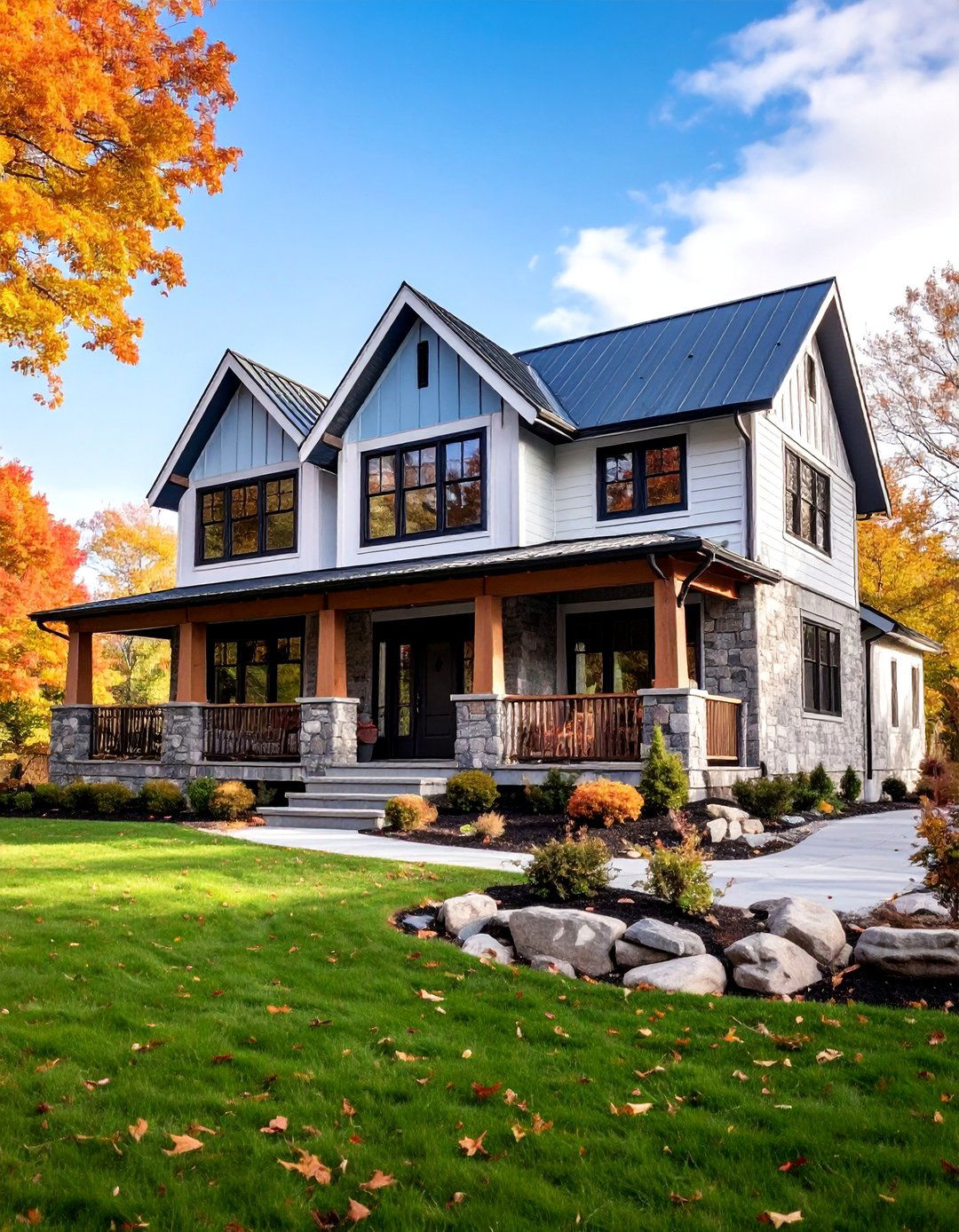
Incorporating natural stone elements transforms a standard farmhouse into an elevated architectural statement. Stone veneer wraps around the foundation, creating visual weight and grounding the structure beautifully. Mixed with white or gray board and batten siding, the stone adds texture and organic appeal that connects the home to its natural surroundings. Popular stone options include limestone, fieldstone, and manufactured stone in neutral earth tones. The combination typically features black metal roofing and dark window frames to maintain the modern aesthetic. Stone accents work particularly well around entries, columns, and garage areas, providing sophisticated contrast against smooth siding materials.
3. Wrap-Around Porch Farmhouse Design
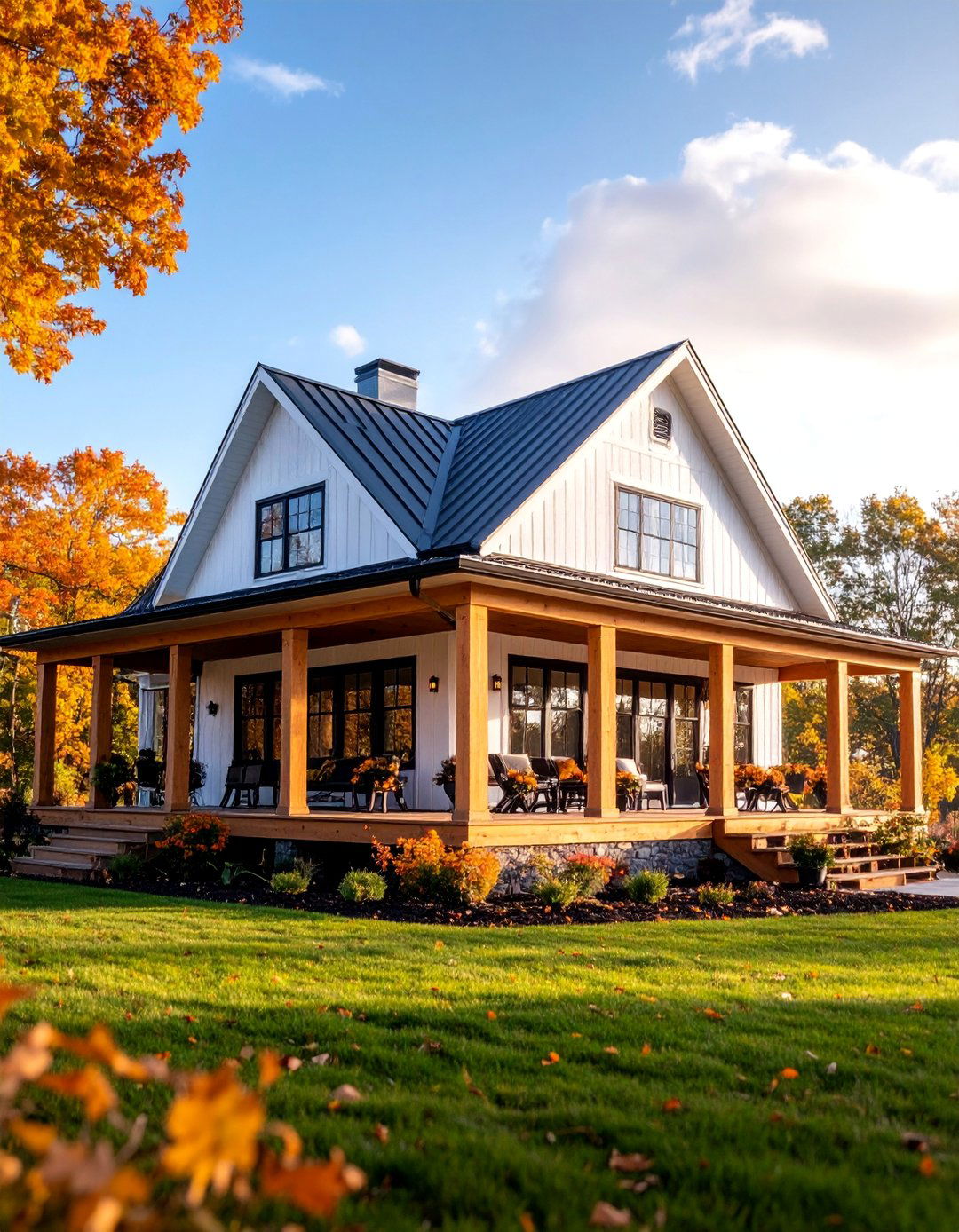
The classic wrap-around porch defines traditional farmhouse living and remains essential in modern interpretations. These expansive covered porches extend along multiple sides of the home, creating generous outdoor living spaces perfect for entertaining and relaxation. Supported by substantial wooden or painted columns, the porch roof typically features metal materials in black or charcoal tones. Board and batten siding in white or soft gray provides the backdrop, while black window trim maintains contemporary edge. The porch depth typically ranges from eight to twelve feet, accommodating comfortable furniture arrangements. This design emphasizes the indoor-outdoor connection that makes farmhouse living so appealing to modern families.
4. Dark Modern Farmhouse with Midnight Black Siding
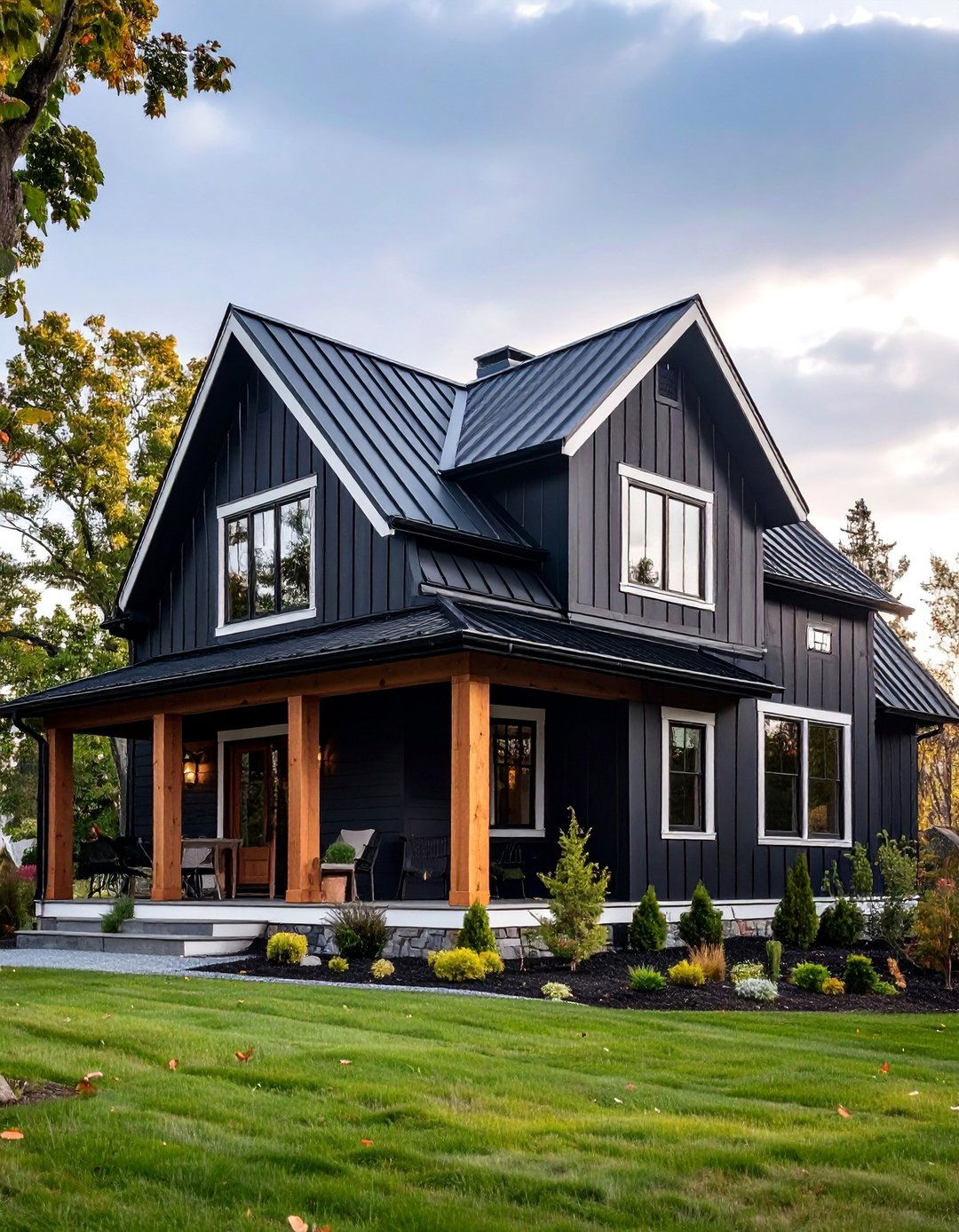
Bold homeowners are embracing dramatic dark exteriors that make powerful architectural statements. Midnight black or charcoal board and batten siding creates striking contrast against white trim and natural wood accents. This sophisticated color choice works particularly well with large windows and glass doors that provide interior light balance. Black metal roofing continues the monochromatic theme while natural wood elements like porch posts and garage doors add warmth. The key to successful dark farmhouse design lies in incorporating sufficient lighting and strategic white or light-colored accents to prevent the exterior from appearing too heavy or imposing in the landscape.
5. Mixed Material Farmhouse with Stucco and Wood

Contemporary farmhouse designs increasingly feature mixed materials that add visual interest and architectural depth. Combining smooth stucco surfaces with traditional board and batten creates compelling textural contrast. The stucco typically appears in warm neutral tones like cream or light gray, while the wood siding might feature natural cedar or painted white finishes. Stone accents around entries and windows provide additional material variety. This approach works particularly well on larger homes where different materials can define separate architectural zones. Metal roofing in dark tones unifies the various materials while maintaining the modern farmhouse aesthetic throughout the design.
6. Rustic Cedar Farmhouse with Natural Wood Tones
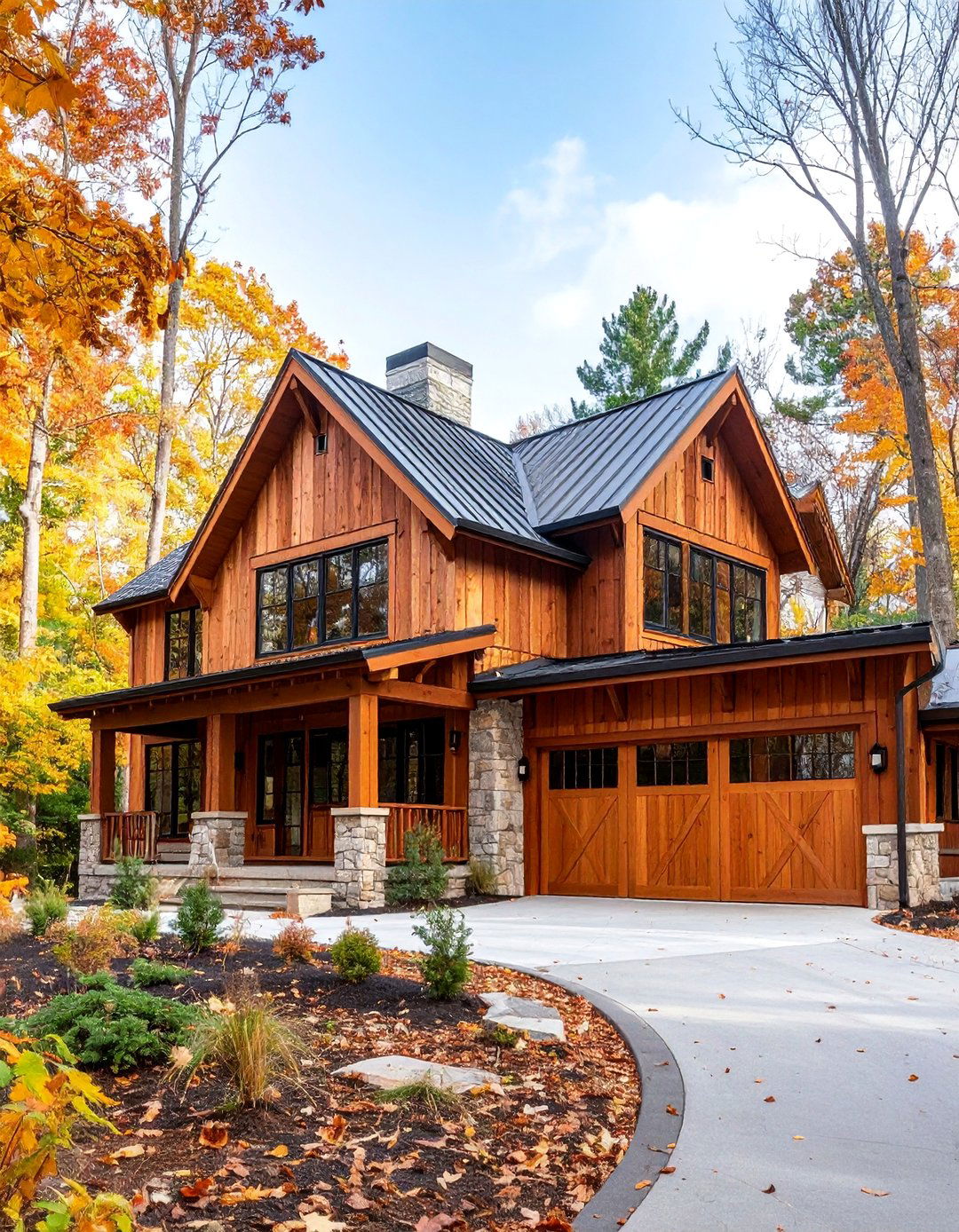
Natural cedar siding brings authentic rustic character to modern farmhouse exteriors while requiring minimal maintenance. The wood's natural oils provide weather resistance and beautiful aging characteristics that develop rich patina over time. Cedar board and batten installation creates traditional farmhouse proportions while the material's natural variations add organic texture. Paired with black metal roofing and dark window frames, cedar siding balances warmth with contemporary sophistication. Natural wood garage doors and porch elements continue the material theme. This approach particularly suits wooded or rural settings where the home should blend harmoniously with natural surroundings while maintaining modern functionality and style.
7. Painted Brick Modern Farmhouse

Painted brick offers durability and timeless appeal in modern farmhouse applications. White or off-white painted brick provides substantial texture while maintaining the clean aesthetic modern farmhouses require. The brick might appear as full exterior cladding or combined with board and batten accents around dormers and gables. Dark mortar joints add definition and prevent the monochromatic appearance from becoming flat. Black window frames and metal roofing continue the high-contrast theme that defines contemporary farmhouse style. This material choice provides excellent longevity and weather resistance while offering the substantial appearance that suits both traditional and modern sensibilities perfectly.
8. Farmhouse with Contrasting Trim Colors
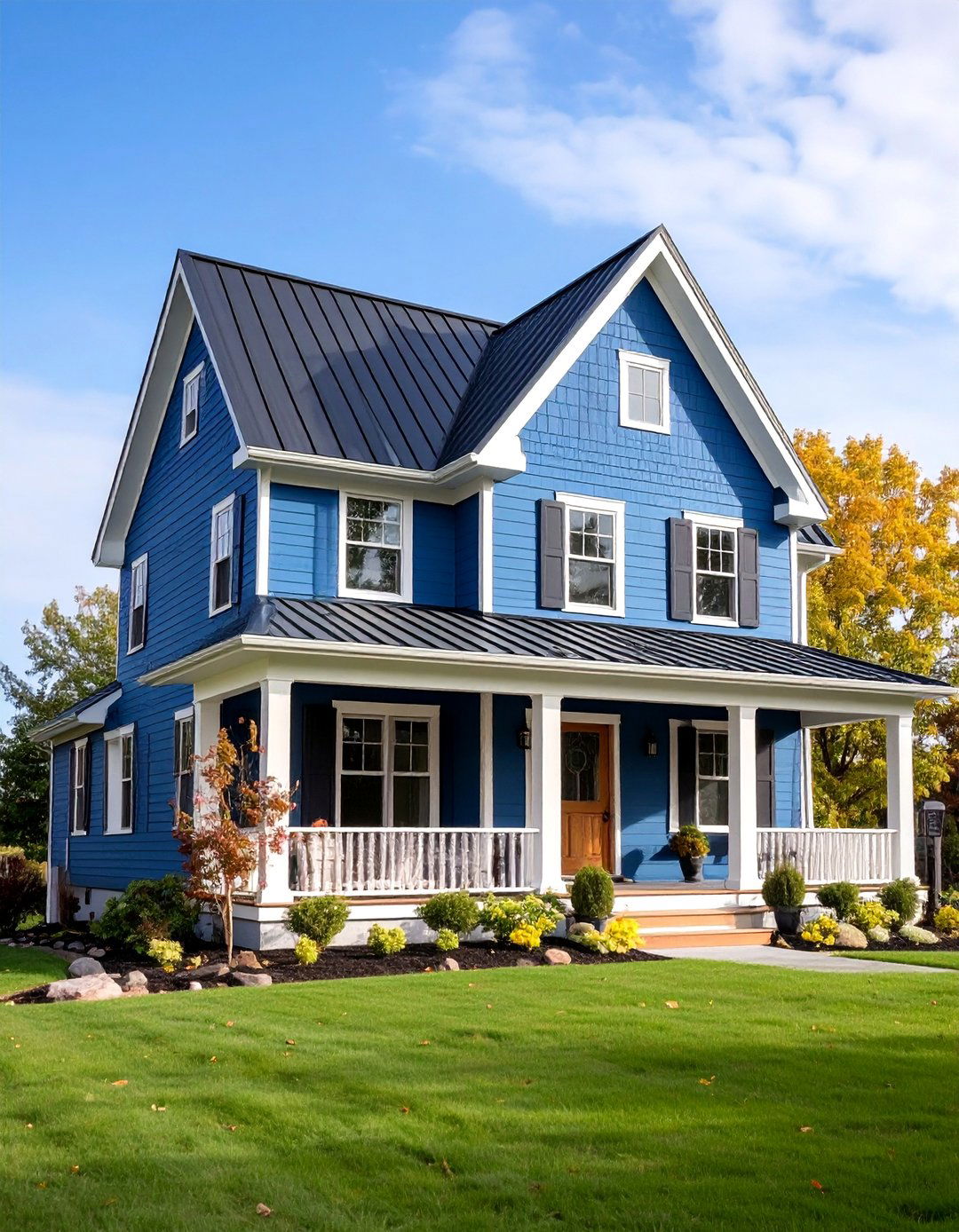
Strategic use of contrasting trim colors elevates basic farmhouse exteriors into sophisticated architectural statements. While maintaining neutral siding in white, cream, or gray, bold trim colors like navy blue, forest green, or charcoal create dramatic definition around windows, doors, and architectural details. This approach allows homeowners to incorporate personality while respecting the farmhouse aesthetic. The contrast technique works particularly well with simple board and batten siding where the trim becomes the primary design element. Metal roofing in complementary dark tones ties the color scheme together while maintaining the modern edge that distinguishes contemporary farmhouse from purely traditional styles.
9. Stone Foundation Farmhouse with Board and Batten
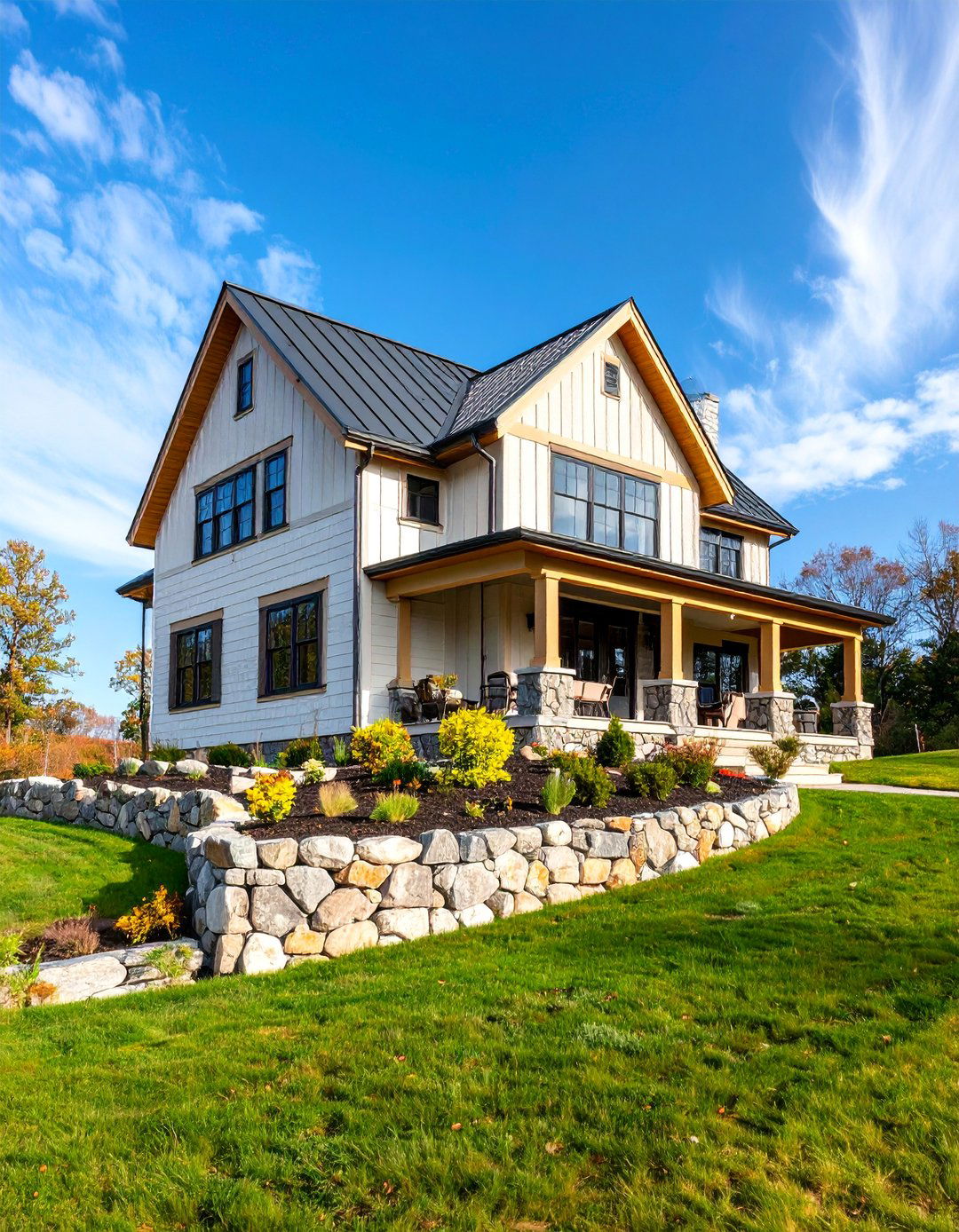
Traditional farmhouse construction often featured stone foundations, and modern interpretations continue this practical and attractive detail. Natural or manufactured stone extends from grade level to approximately three feet high, creating visual weight and weather protection. Above the stone, board and batten siding in white or light gray provides classic farmhouse proportions. The stone typically features earth tones that complement the surrounding landscape while the siding maintains clean, contemporary lines. Black window frames and metal roofing complete the modern transformation. This foundation treatment works particularly well on sloping sites where the stone can follow natural grade changes while providing consistent architectural character.
10. Dutch Door Farmhouse Entry Design
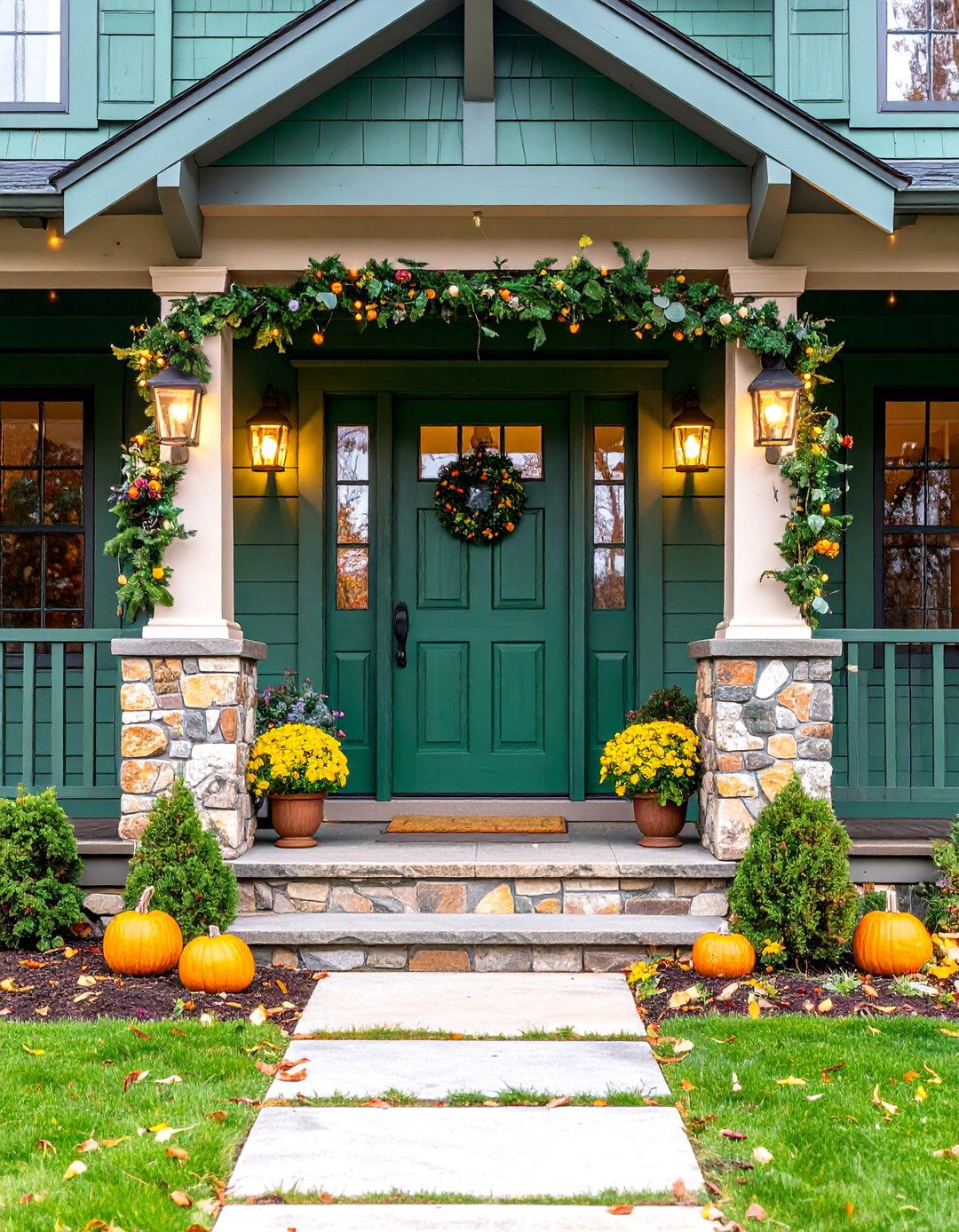
Dutch doors serve as focal points in modern farmhouse exteriors, combining practical functionality with distinctive architectural character. These split doors allow natural ventilation while maintaining security, perfectly embodying farmhouse practicality. The door typically features natural wood finish or bold paint colors like navy, forest green, or classic black. Surrounding the Dutch door, board and batten siding and stone or brick accents create inviting entry sequences. Covered porches provide weather protection while vintage-inspired lighting fixtures enhance the traditional atmosphere. The Dutch door's unique horizontal division adds visual interest that distinguishes the entry from standard door installations while celebrating authentic farmhouse heritage.
11. Gambrel Roof Modern Farmhouse
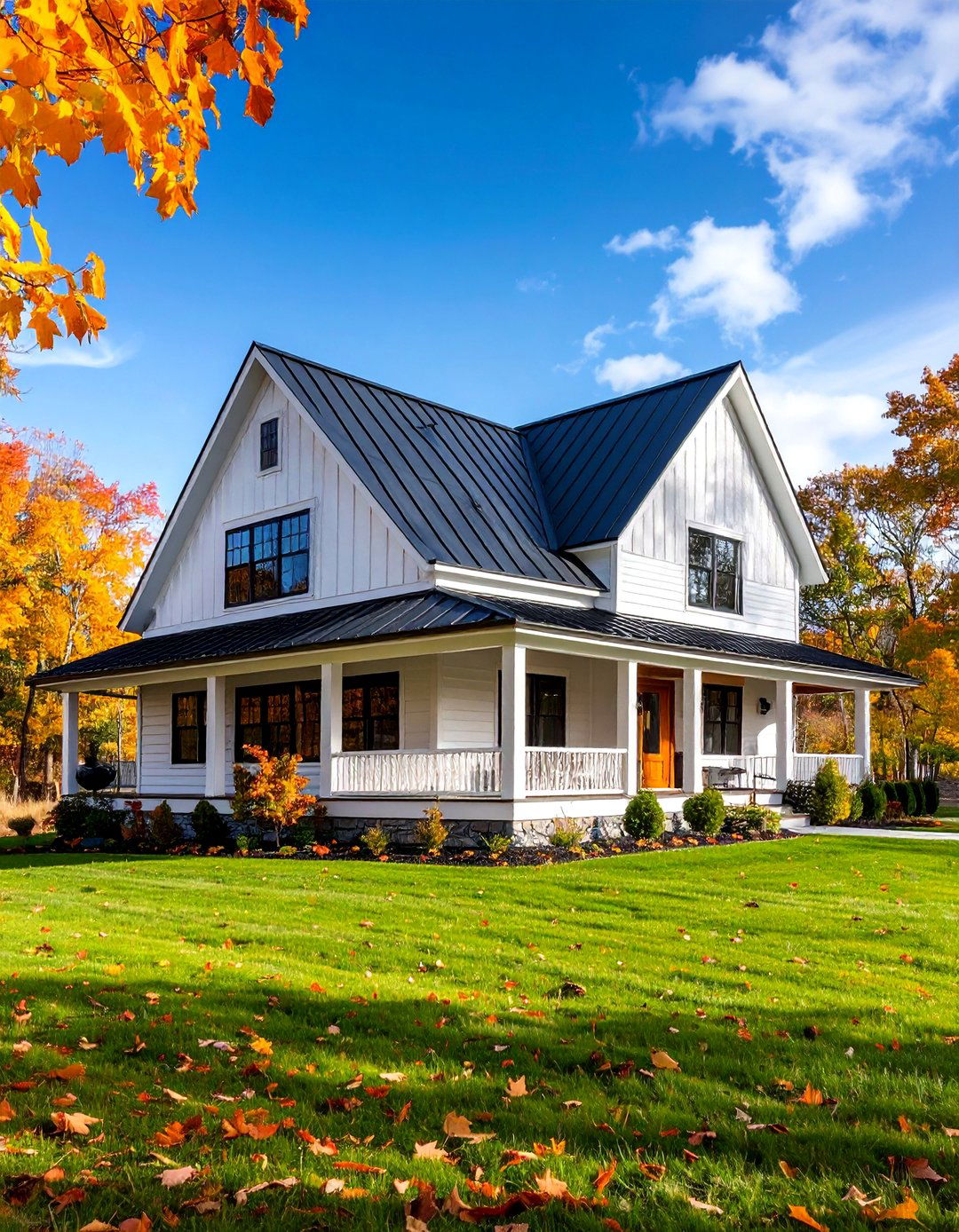
The gambrel roof profile immediately evokes barn architecture while providing practical advantages in modern farmhouse applications. This distinctive roofline features two slopes on each side, with the lower slope steeper than the upper, maximizing interior space and creating dramatic exterior proportions. Metal roofing in black or dark gray emphasizes the roof's architectural lines while board and batten siding continues the agricultural reference. Large windows positioned strategically take advantage of the gambrel's height while dormer windows provide additional light and ventilation. This roof style works particularly well on larger farmhouse designs where the dramatic profile can be properly proportioned.
12. Modern Farmhouse with Industrial Lighting
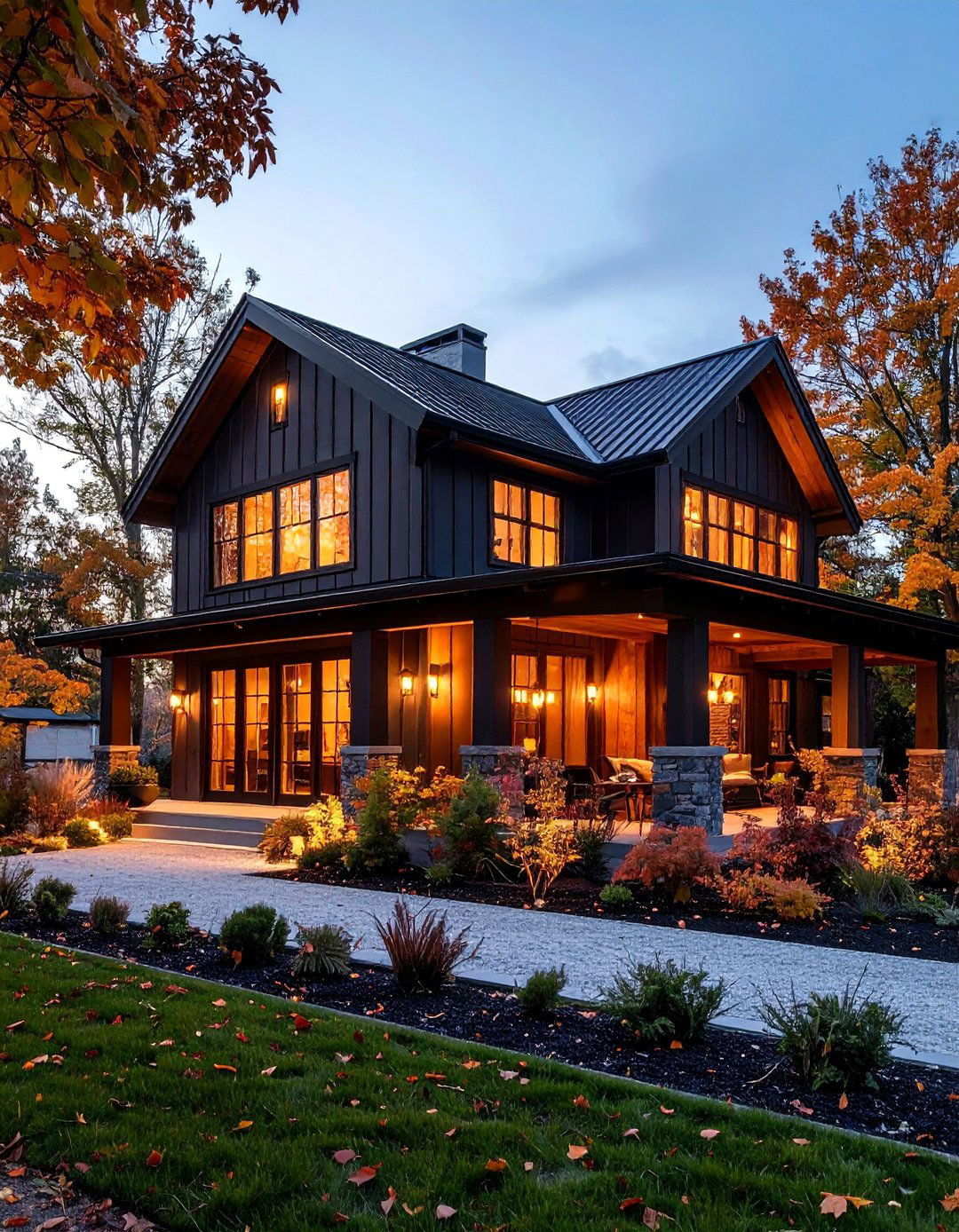
Industrial-style lighting fixtures provide authentic farmhouse character while meeting contemporary design standards. Barn lights, warehouse sconces, and vintage-inspired lanterns create warm, welcoming illumination that highlights architectural details during evening hours. These fixtures typically feature matte black or galvanized metal finishes that complement black window frames and metal roofing. Positioned around entries, porches, and garage areas, industrial lighting reinforces the agricultural heritage while providing necessary functionality. The oversized proportions typical of farmhouse lighting create bold visual statements that balance the substantial scale of board and batten siding and generous porch structures. Quality fixtures ensure longevity and weather resistance.
13. Horizontal and Vertical Siding Combination

Mixing horizontal and vertical siding orientations adds visual complexity to modern farmhouse exteriors while maintaining clean, contemporary lines. Board and batten installation might appear on upper levels or specific architectural zones while horizontal lap siding covers main level areas. This combination prevents large wall surfaces from appearing monotonous while creating subtle architectural hierarchy. The different orientations can emphasize various design elements, with vertical siding drawing attention upward and horizontal siding creating broader, more grounded proportions. Consistent color application unifies the mixed orientations while varying textures provide sophisticated visual interest throughout the exterior composition.
14. Covered Entry Porch Design
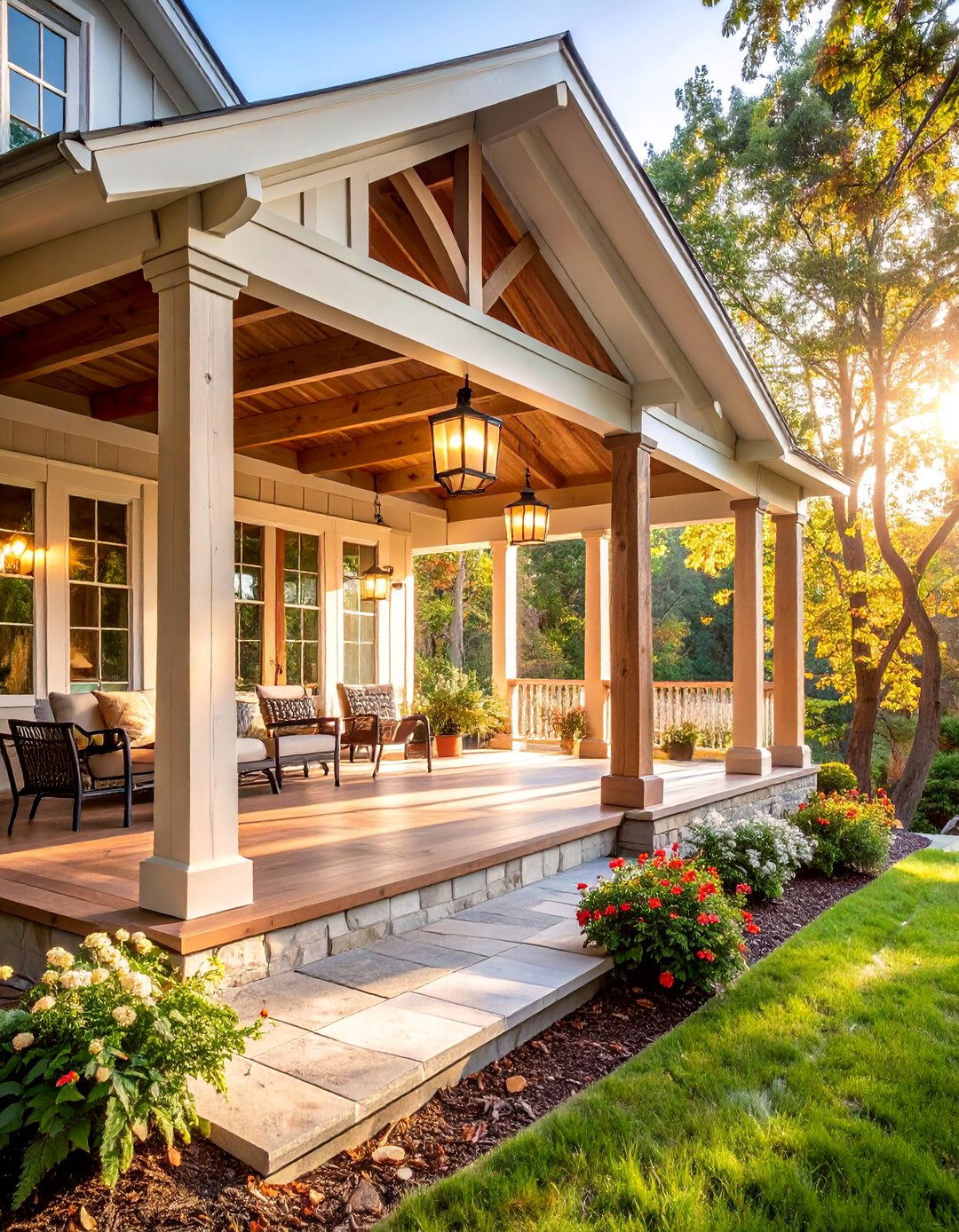
Generous covered entry porches create welcoming arrival sequences that embody farmhouse hospitality traditions. These structures typically extend eight to twelve feet from the main house, providing weather protection and outdoor living space. Substantial columns or posts support the porch roof, which often features exposed wooden beams or metal framework. The porch floor might utilize natural stone, brick pavers, or painted wooden decking, depending on the overall design aesthetic. Ceiling fans and pendant lighting enhance functionality while vintage-inspired furnishings complete the outdoor room concept. The covered porch serves as a transitional space between public and private realms, essential to authentic farmhouse living.
15. Shed Dormer Farmhouse Design
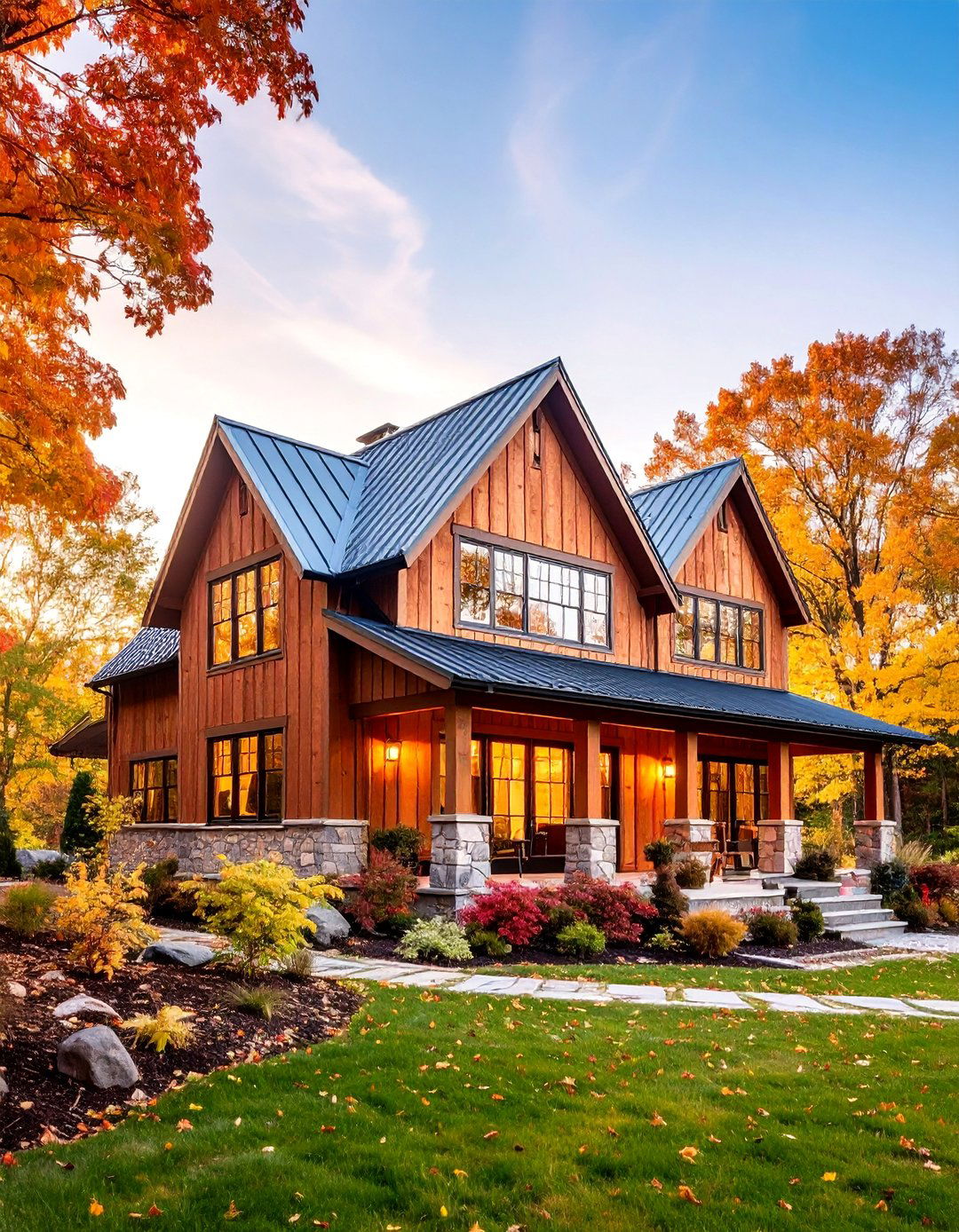
Shed dormers provide practical interior space while creating distinctive exterior architectural character. These elongated dormer windows extend along significant portions of the roofline, maximizing natural light penetration to upper level spaces. The dormer faces typically feature board and batten siding that matches or contrasts with the main house materials. Large windows within the dormer openings emphasize the contemporary aspect of modern farmhouse design. Metal roofing continues across both main roof and dormer surfaces, maintaining visual continuity. This dormer style works particularly well on houses where upper level living spaces require generous natural light and headroom for comfortable occupation.
16. Modern Farmhouse with Shutters
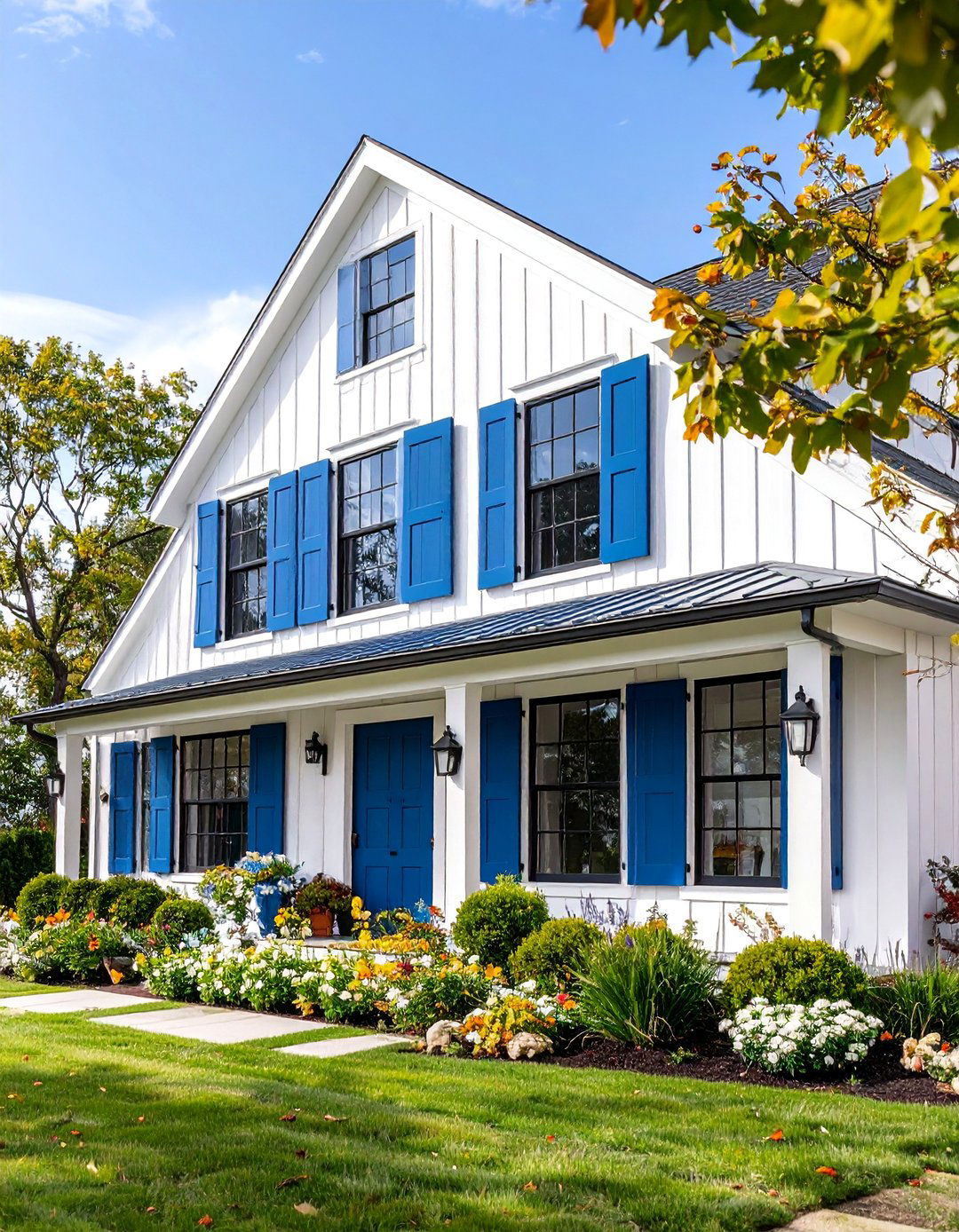
Functional or decorative shutters add traditional farmhouse character while providing opportunities for color accent and architectural definition. Board and batten shutters complement the primary siding while creating layered visual texture around windows. Shutter colors might match trim elements or introduce contrasting tones like navy blue, forest green, or classic black. Hardware details including hinges and holdbacks should reflect quality craftsmanship that supports the authentic farmhouse aesthetic. Whether operational or decorative, shutters must be proportioned correctly to window openings to maintain architectural credibility. This traditional element bridges historical farmhouse heritage with contemporary design sensibilities effectively.
17. Natural Wood and White Combination
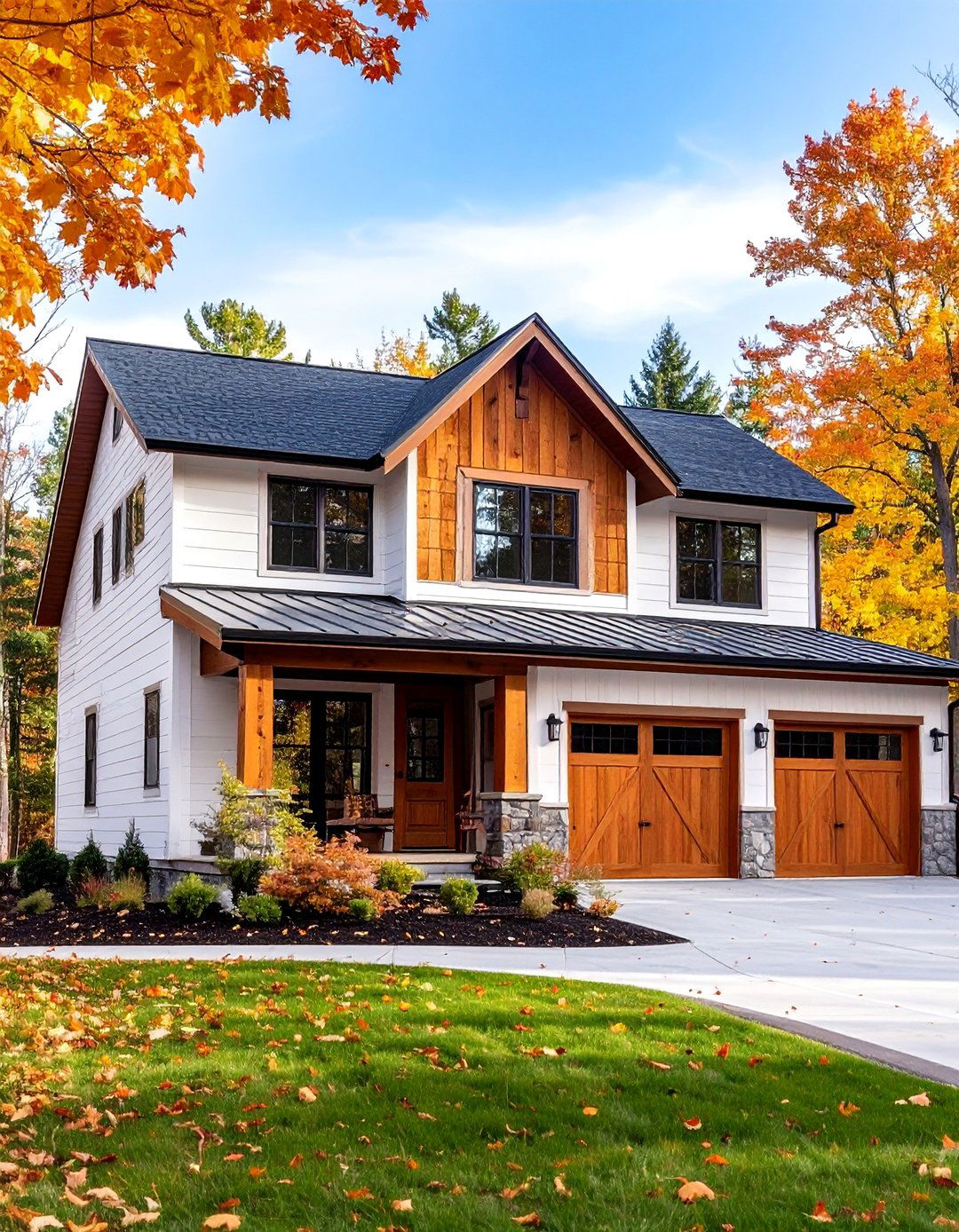
Combining natural wood elements with crisp white siding creates balanced exteriors that celebrate both contemporary and traditional farmhouse qualities. Cedar or pine board and batten sections might accent specific architectural zones while white painted siding covers primary wall surfaces. The natural wood typically appears around entries, garage doors, or porch elements where the organic texture provides welcome relief from painted surfaces. This material combination requires careful maintenance to preserve the wood's natural beauty while ensuring long-term durability. The contrast between natural and painted elements creates sophisticated visual hierarchy that distinguishes quality farmhouse design from purely utilitarian agricultural structures.
18. L-Shaped Farmhouse Layout
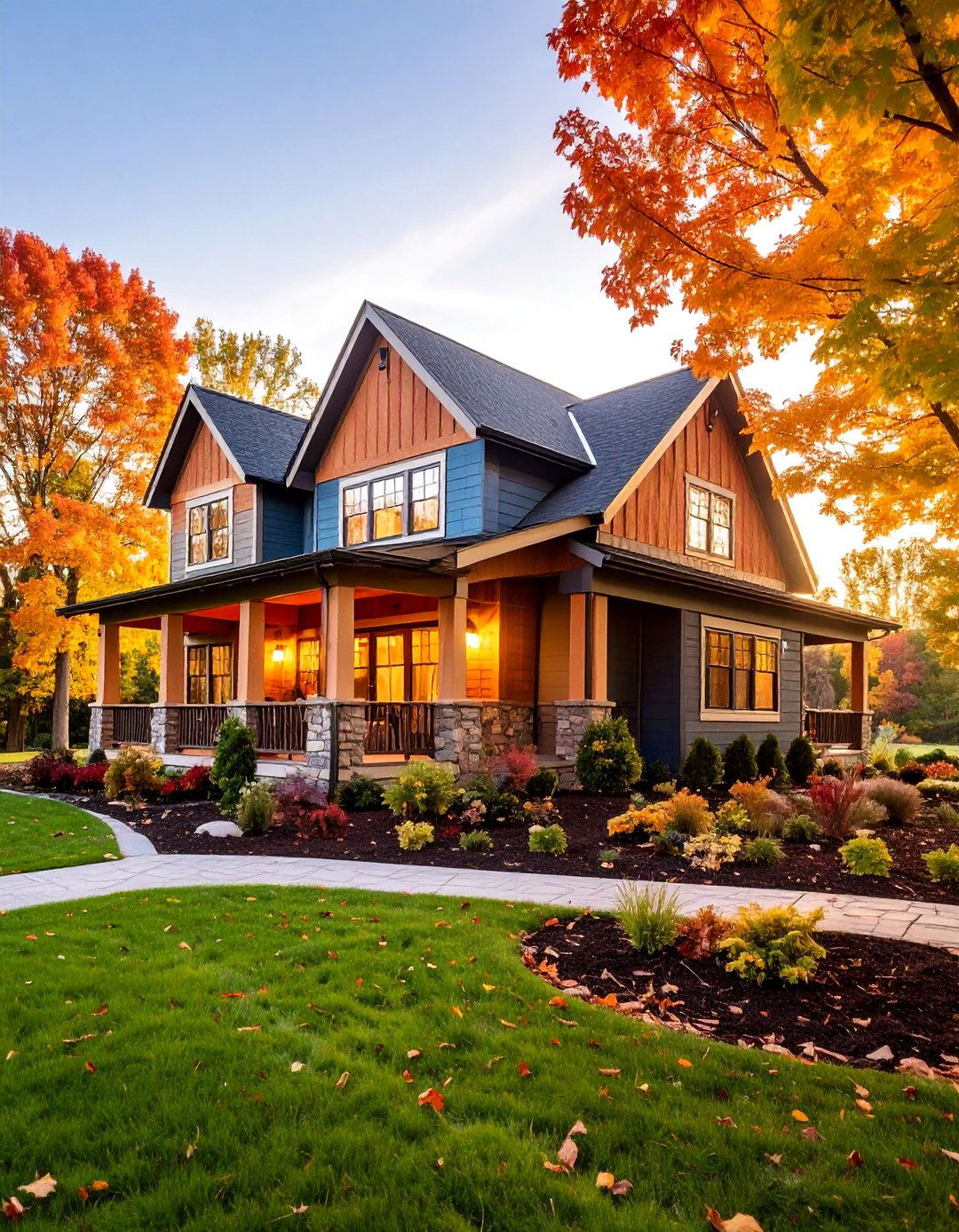
L-shaped floor plans create natural opportunities for covered porch integration and varied exterior compositions. The building configuration provides protected outdoor spaces where the two wings meet while allowing different material treatments on separate sections. Board and batten siding might appear on one wing while stone or brick accents distinguish connecting elements. This layout accommodates natural site conditions effectively while providing multiple orientation options for windows and entries. The resulting exterior features varied rooflines, material transitions, and porch relationships that create architectural interest without compromising the clean lines essential to modern farmhouse aesthetic.
19. Metal Accent Modern Farmhouse

Strategic metal accents distinguish contemporary farmhouse designs while maintaining agricultural authenticity. Corrugated metal siding might appear on specific architectural zones like dormers or porch ceilings, providing textural contrast against smooth board and batten surfaces. Metal awnings over windows or entries continue the industrial theme while providing practical weather protection. These accents typically feature galvanized, weathered, or painted finishes that complement the overall color scheme. The key lies in using metal elements thoughtfully rather than overwhelming the design with industrial materials. Quality metal products ensure longevity and develop attractive patina characteristics that enhance the farmhouse aesthetic over time.
20. Gable End Window Farmhouse
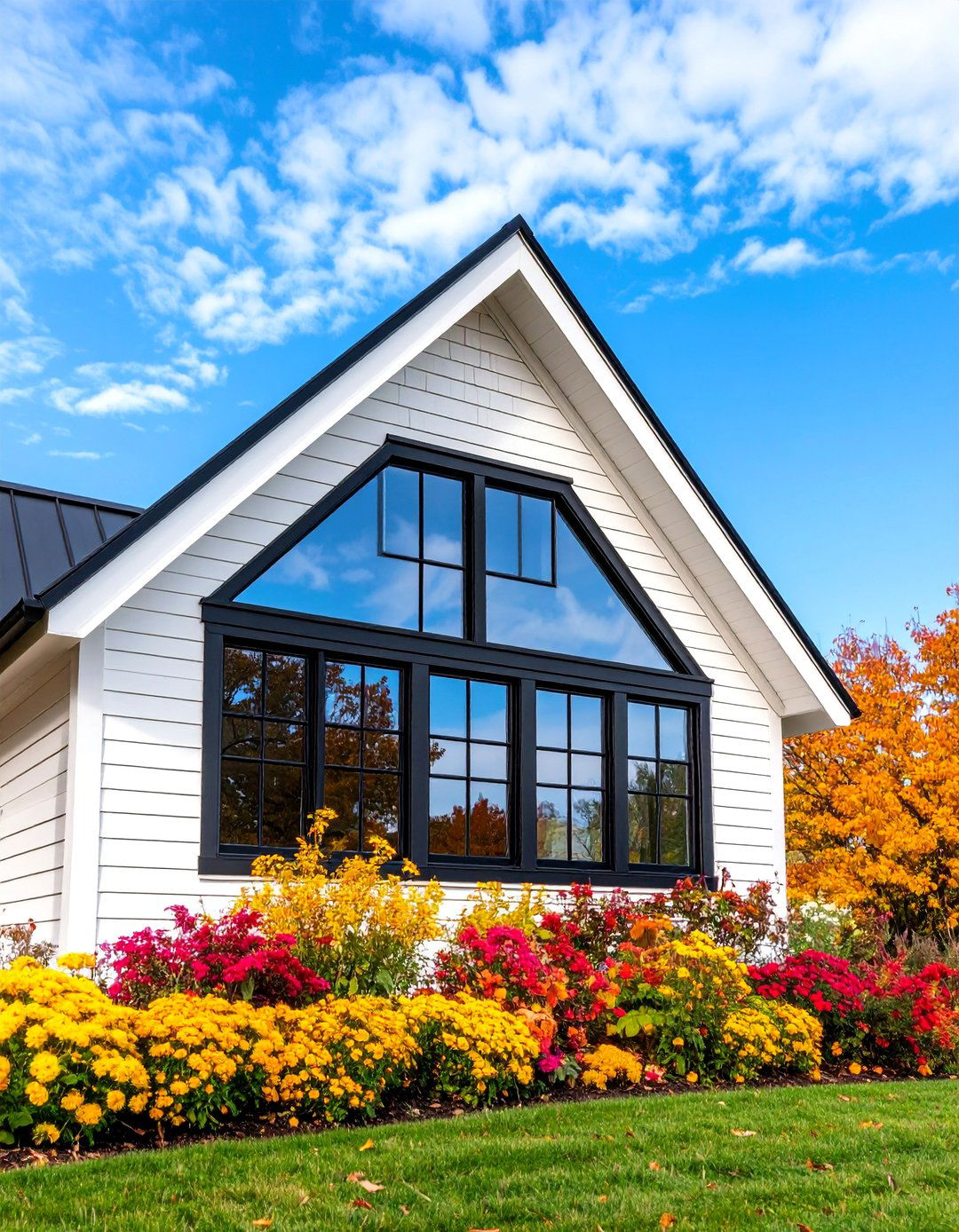
Large gable end windows create dramatic focal points while maximizing natural light penetration to interior spaces. These oversized windows often feature geometric patterns or divided light configurations that reference traditional farmhouse glazing systems. The surrounding siding treatment typically emphasizes the gable geometry through material changes or trim details. Black window frames maintain contemporary edge while the generous glazing area connects interior spaces with exterior views effectively. This design strategy works particularly well where scenic vistas or natural light optimization are priorities. The substantial window proportions require careful structural consideration but create stunning architectural statements that distinguish quality farmhouse design.
21. Screened Porch Addition

Screened porches extend farmhouse living seasons while providing protected outdoor spaces perfect for dining and relaxation. These additions typically feature traditional porch proportions with substantial posts or columns supporting hip or gabled roofs. The screening system allows natural ventilation while preventing insect intrusion, making these spaces practical in various climates. Interior ceiling treatments might include exposed beams, tongue and groove planking, or painted surfaces that complement the main house interior. Lighting fixtures and ceiling fans enhance functionality while appropriate furnishings complete the outdoor room concept. Screened porches represent the evolution of traditional farmhouse porches for contemporary living patterns.
22. Contemporary Farmhouse with Clean Lines
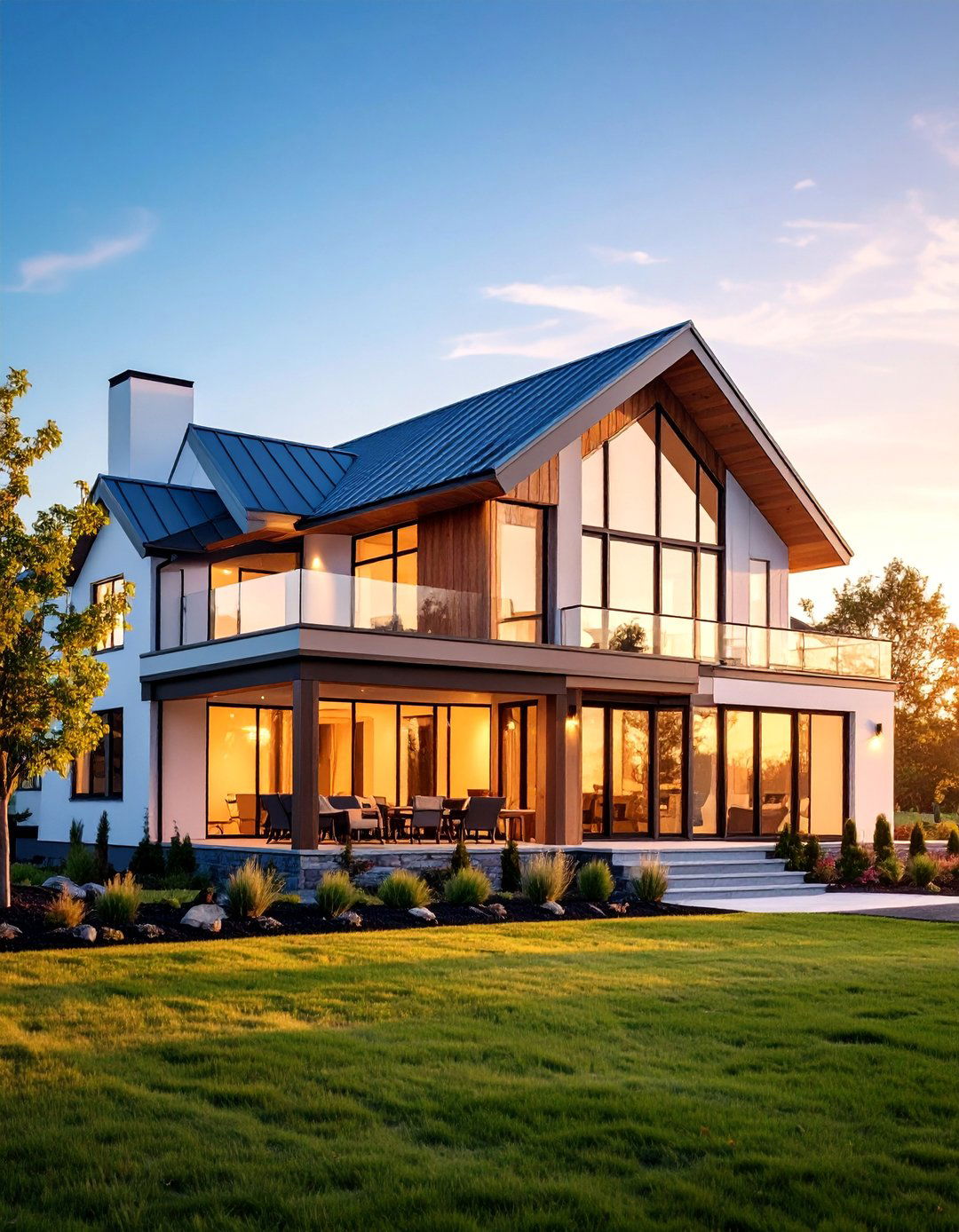
Simplified farmhouse interpretations emphasize clean geometric forms while retaining agricultural references through material selection and proportional relationships. Board and batten siding maintains traditional texture while large, unadorned windows and minimal trim details create contemporary sophistication. The roof forms might feature simple gables or hip configurations without decorative elements that could compromise the streamlined aesthetic. Color palettes typically utilize whites, grays, and blacks in high-contrast combinations that emphasize architectural geometry. This approach suits homeowners who appreciate farmhouse character but prefer minimalist design sensibilities. The result bridges traditional and contemporary styles effectively while maintaining authentic farmhouse proportions.
23. Stone Chimney Farmhouse Character

Substantial stone chimneys provide vertical emphasis and authentic farmhouse character that distinguishes quality design from basic interpretations. Natural stone construction creates visual weight that balances horizontal siding elements while the chimney mass suggests interior fireplace amenities essential to farmhouse living. The stonework typically features earth tones that complement surrounding materials while mortar joints provide definition and weather protection. Chimney proportions must relate properly to overall house scale to maintain architectural credibility. This traditional element references historical farmhouse construction methods while providing practical function that supports contemporary lifestyle expectations. Quality stone construction ensures longevity and develops attractive weathering characteristics over time.
24. Covered Walkway Connection
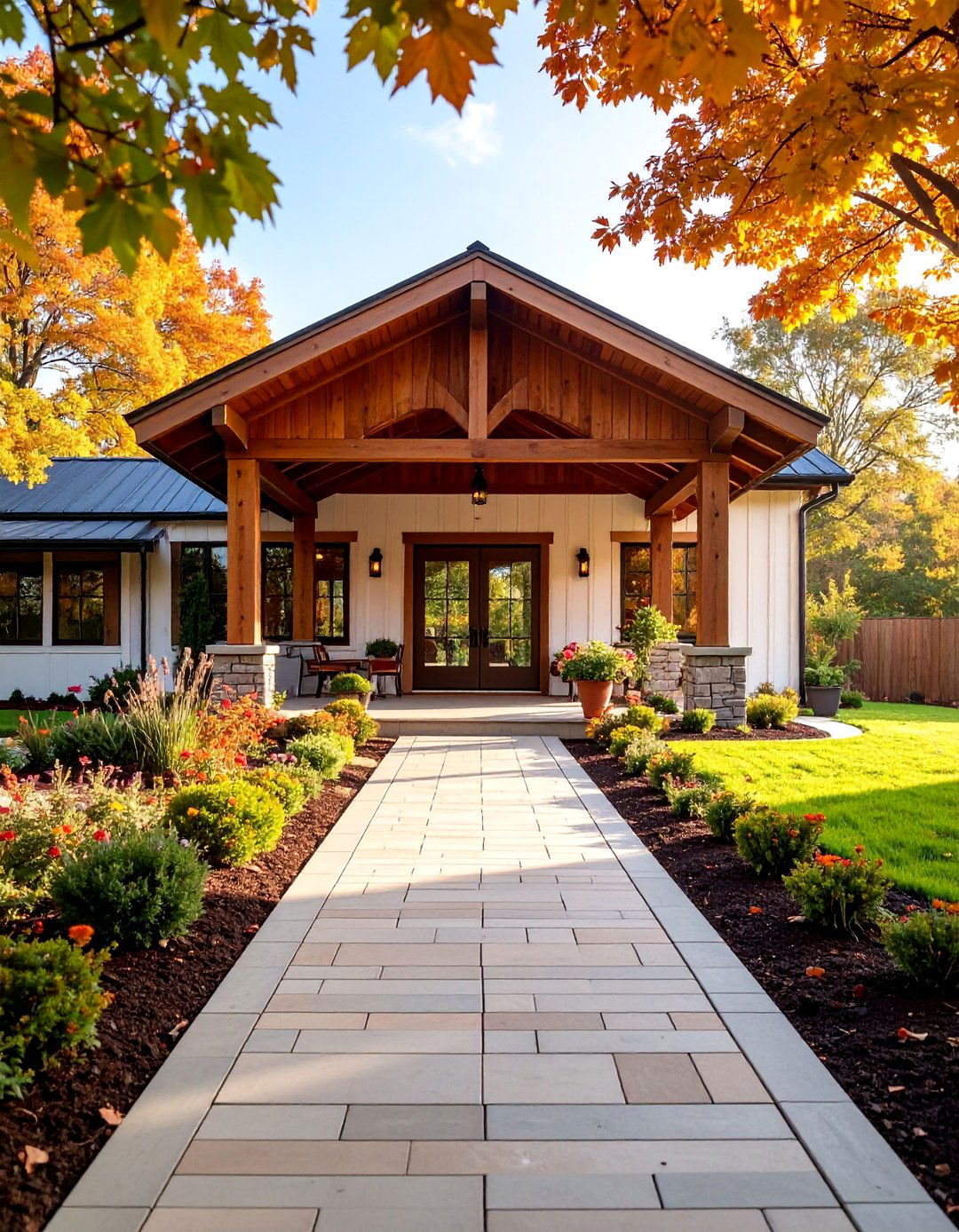
Covered walkways connecting main houses to detached garages or outbuildings create cohesive farmhouse compounds while providing weather protection and architectural continuity. These structures typically feature similar materials and proportions to the main house while serving as transition elements between buildings. The walkway roof might extend from existing porch structures or stand independently with posts or columns providing structural support. Board and batten siding often continues along walkway walls while metal roofing maintains visual consistency throughout the complex. This design strategy works particularly well on larger properties where multiple structures require coordination while maintaining individual architectural identity within the overall farmhouse aesthetic.
25. Regional Farmhouse Adaptation

Modern farmhouse designs adapt successfully to various regional conditions while maintaining core aesthetic principles through thoughtful material selection and proportional relationships. Southern interpretations might emphasize covered porches and elevated foundations while mountain versions feature steeper roof pitches and stone foundations. Coastal farmhouses incorporate weather-resistant materials and hurricane preparation features while maintaining board and batten character. The key lies in respecting local building traditions and climate requirements while preserving the essential farmhouse elements that define the architectural style. Regional adaptations ensure that modern farmhouse designs integrate successfully with local contexts while meeting contemporary performance and lifestyle expectations effectively.
Conclusion:
Modern farmhouse exteriors continue evolving while maintaining their essential appeal through timeless material combinations and functional design principles. The style's enduring popularity stems from its successful balance of rustic authenticity and contemporary sophistication, creating homes that feel both welcoming and stylish. From classic white board and batten combinations to bold dark siding with natural accents, these 25 design approaches demonstrate the versatility and adaptability that make modern farmhouse architecture suitable for diverse settings and personal preferences while maintaining architectural integrity.


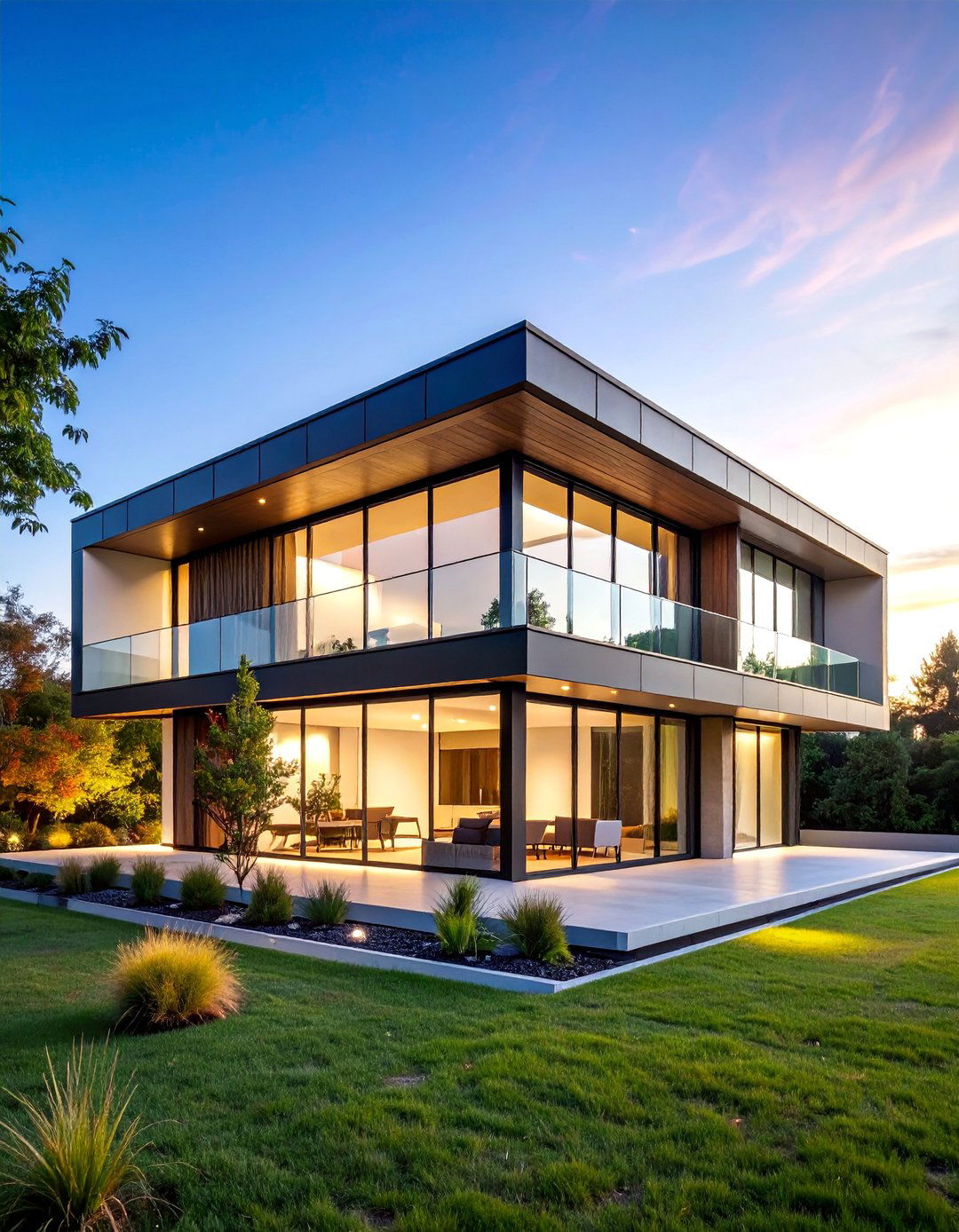
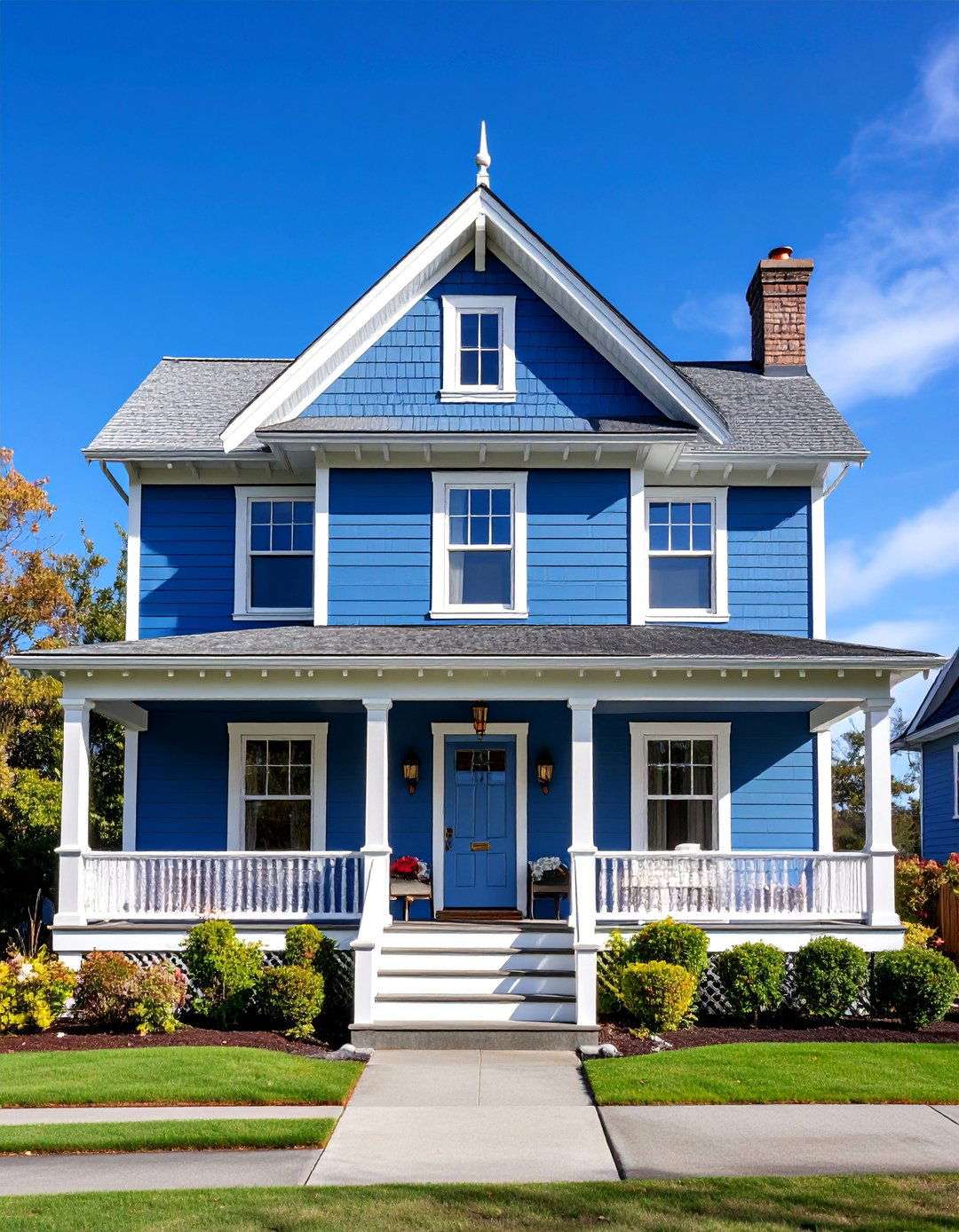

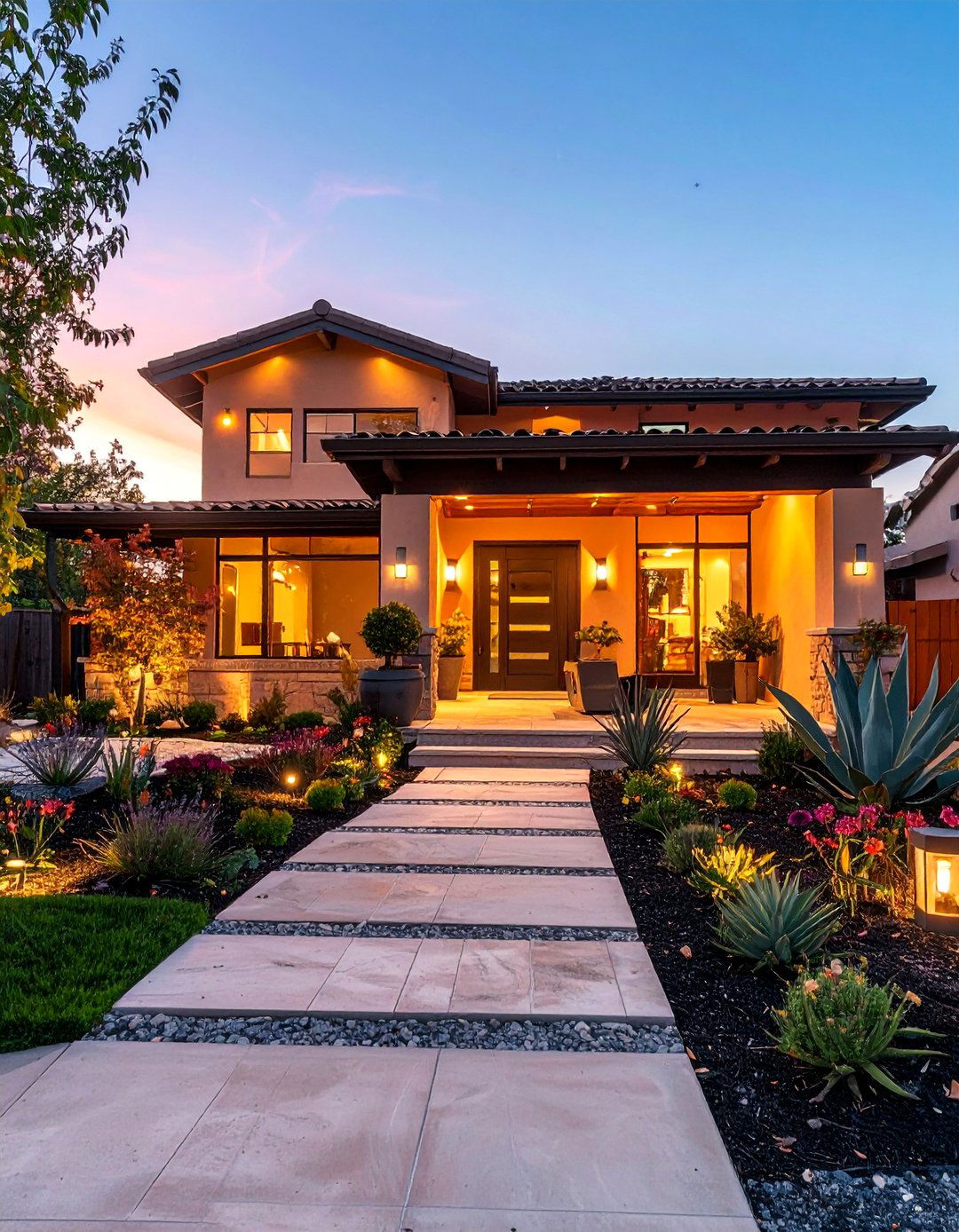
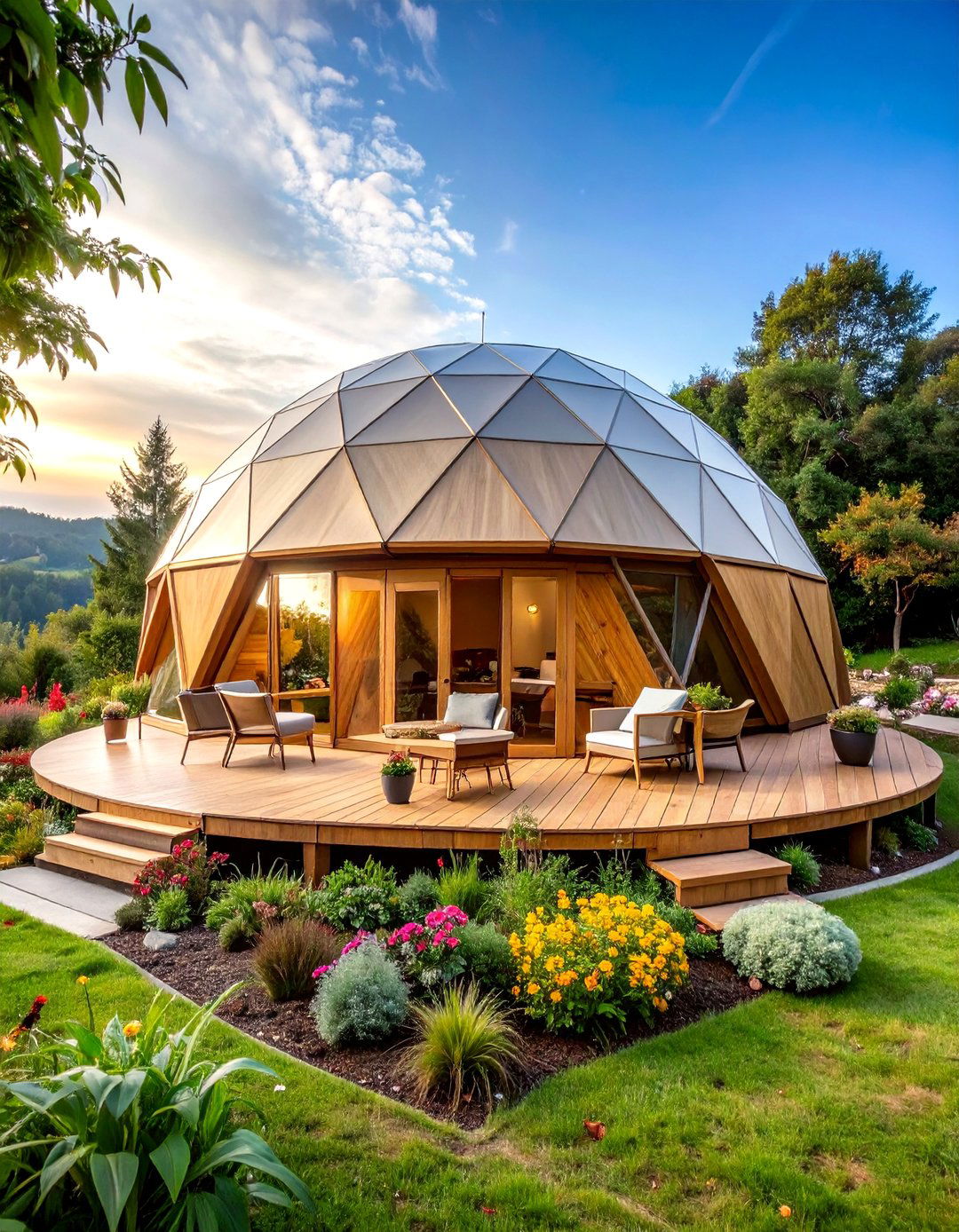

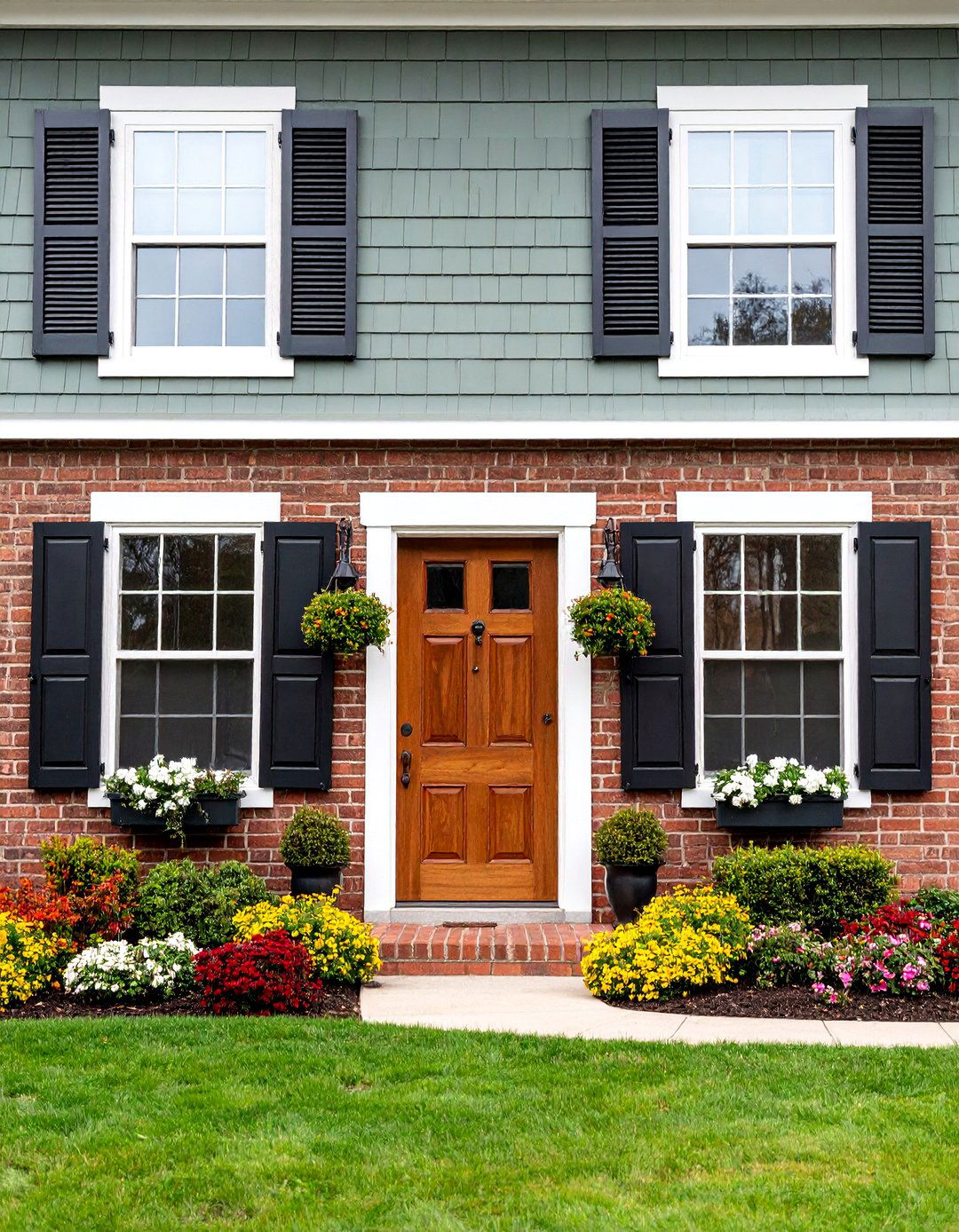




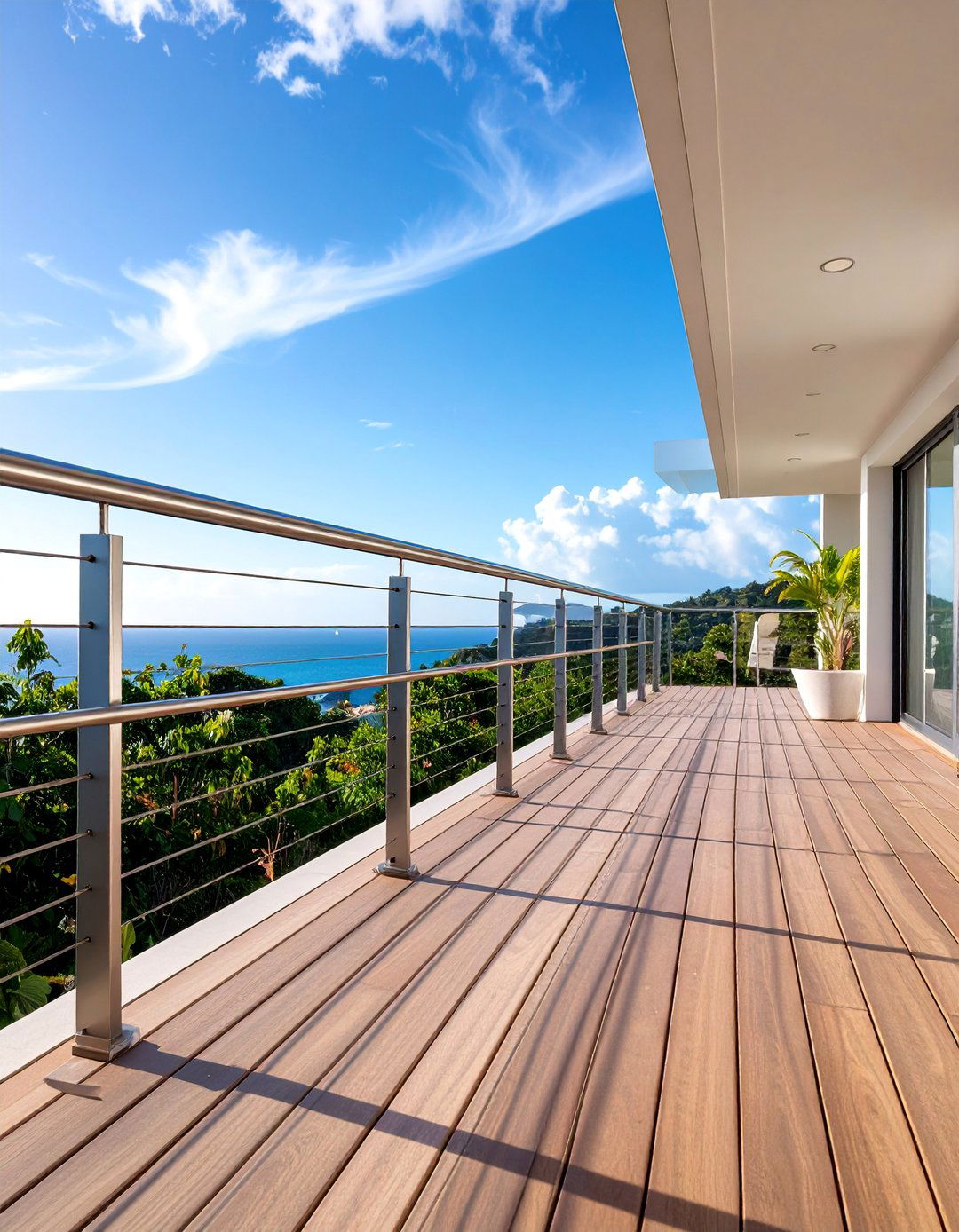



Leave a Reply